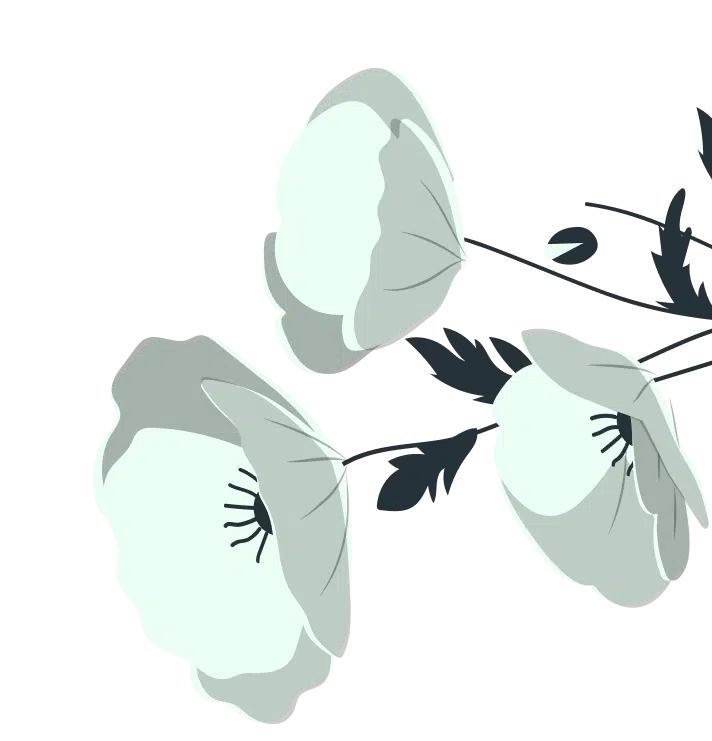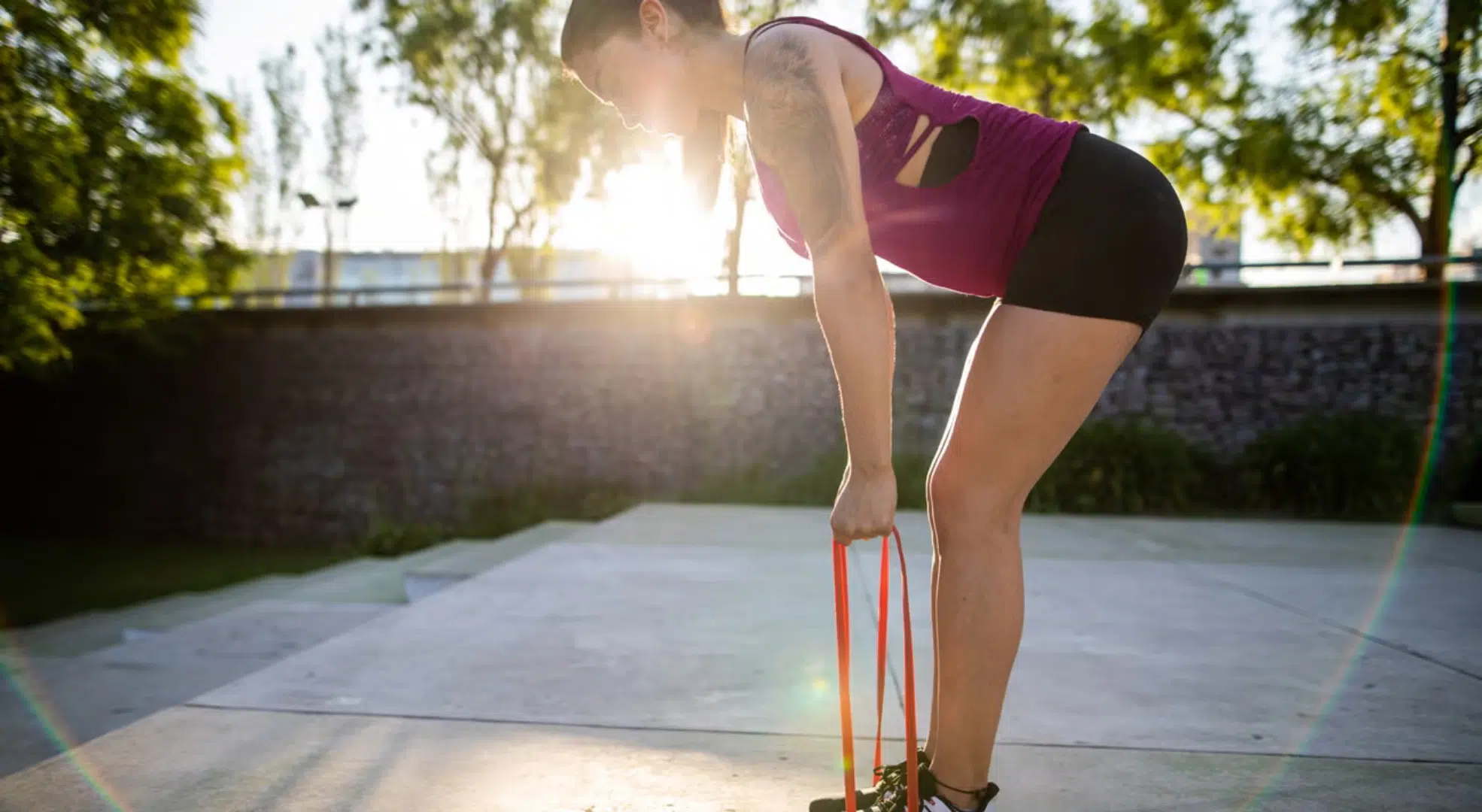Feeling stiff or tight in your body lately? I’ve been there too. That’s where yoga strap stretches really come in handy.
If you find it hard to reach your feet, hold certain poses, or just feel tense, a yoga strap can make stretching much easier. You don’t need to be super flexible or have any special skills to get started.
I’ll walk you through some simple stretches using a yoga strap. We’ll focus on your legs, shoulders, and back, areas that often hold stress.
These stretches can help you feel more relaxed, move more freely, and let go of tightness. You can use them before or after workouts, or anytime your body needs a break.
If you’re looking for an easy way to stretch safely and feel better, you’re in the right place. Let’s make your body feel good again.
What is a Yoga Strap and Why Use It?
A yoga strap is a simple band, usually made of cotton or nylon, that helps you stretch better and hold poses longer. It’s great for people who are just starting yoga, feel tight in their muscles, or are healing from injuries.
It helps improve your posture, makes stretching easier and safer, and gives support when you can’t reach your toes or hands yet.
Beginners who can’t stretch all the way, people with stiff muscles, and anyone coming back from an injury can all benefit from using one. A yoga strap makes your practice safer, smoother, and more comfortable.
Easy Yoga Strap Stretches You Can Try
Using a yoga strap can help you stretch deeper, hold poses longer, and stay safe while doing it. These simple strap stretches are great for beginners, people with tight muscles, or anyone who just wants a little extra support during yoga:
1. Seated Forward Fold
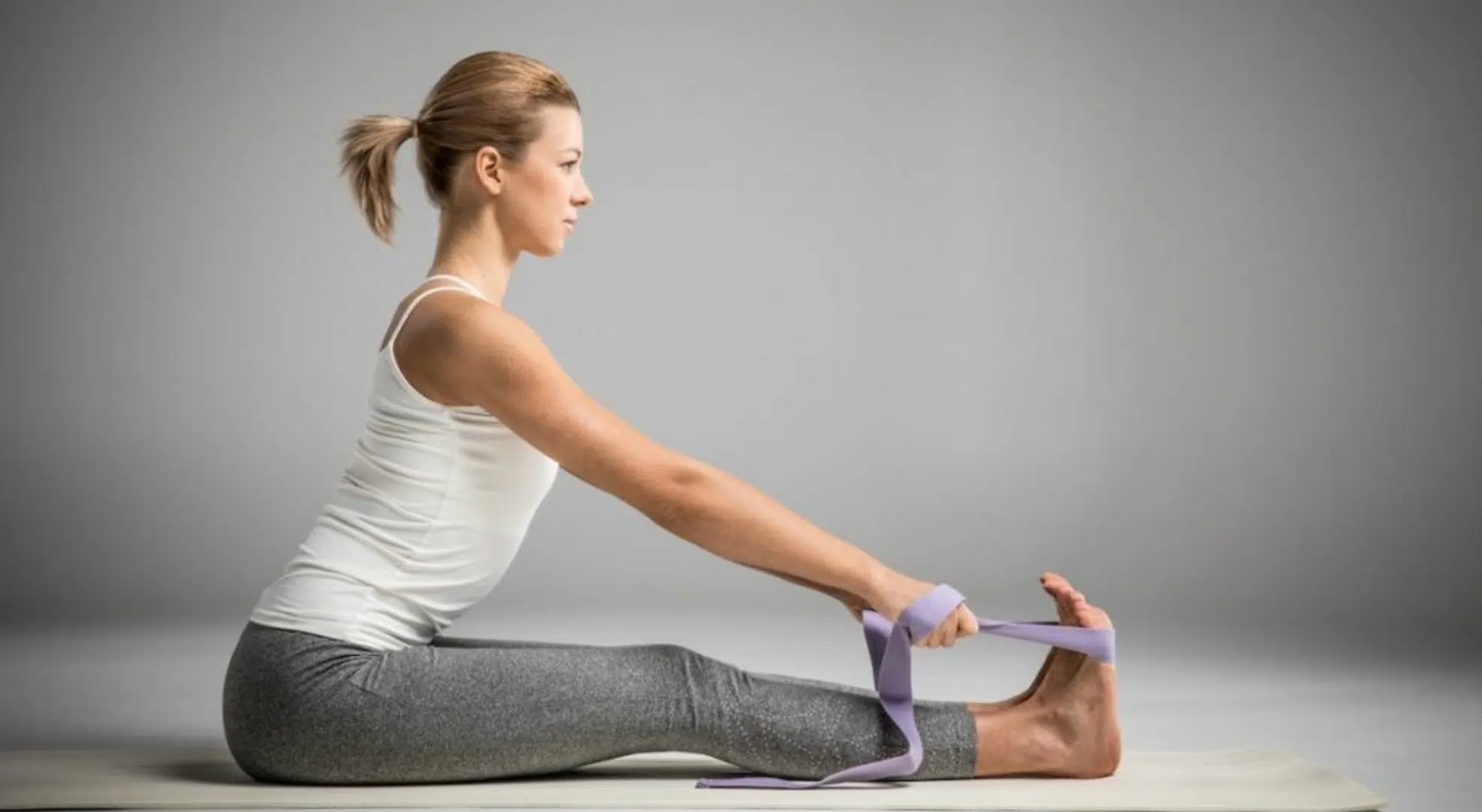

Target: Hamstrings, calves
Sit with your legs stretched out in front of you. Loop the strap around the balls of your feet and gently pull yourself forward while keeping your back straight.
Focus on bending at the hips, not the waist, and don’t force your head to your knees. Use the strap to slowly deepen the stretch. Breathe slowly and keep your chest open as you lean forward with control.
2. Reclining Hamstring Stretch
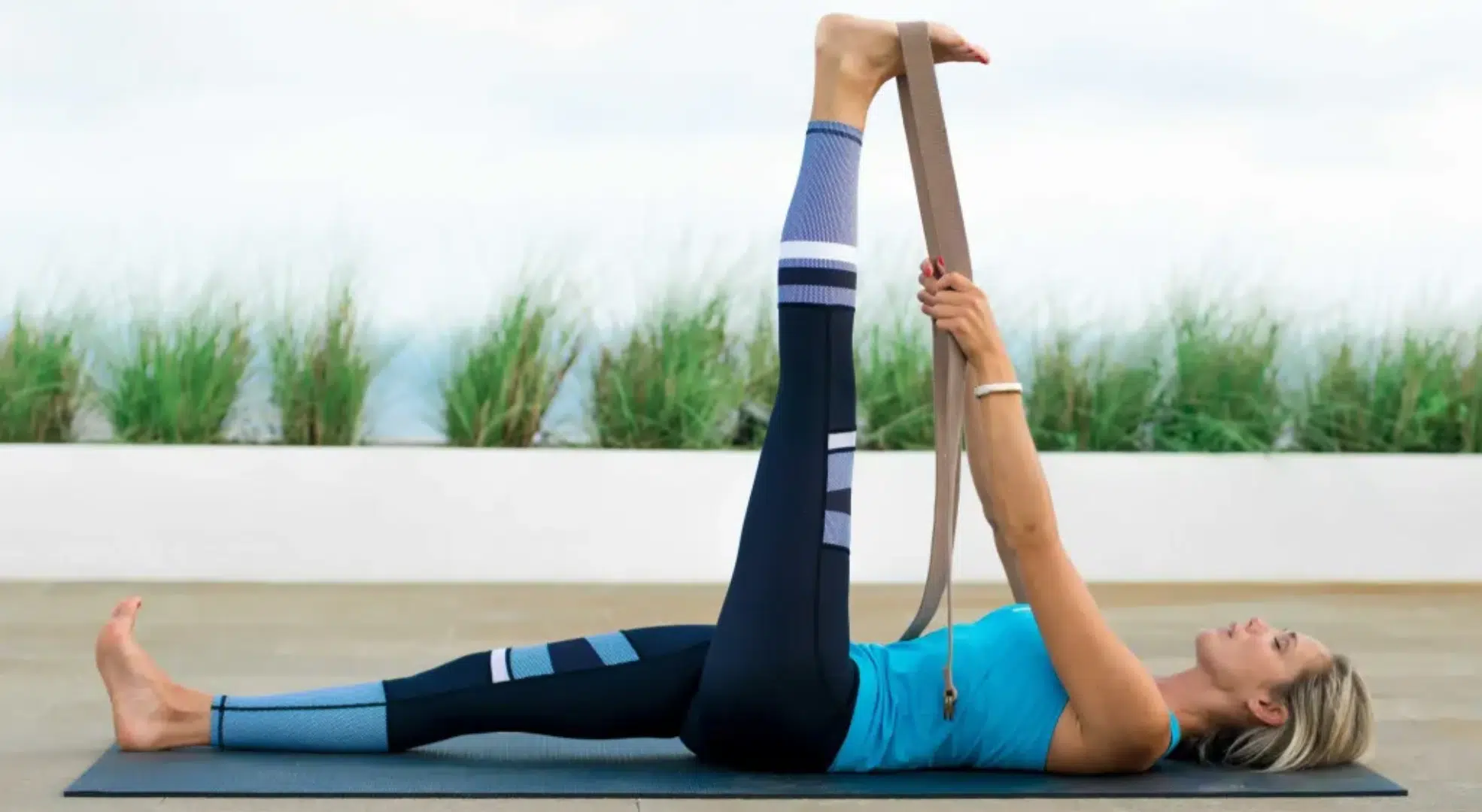

Target: Hamstrings, lower back
Lie on your back and loop the strap around the arch of one foot. Keep your other leg flat on the floor. Slowly raise your strapped leg toward the ceiling while holding both ends of the strap.
Keep your leg straight but avoid locking the knee. Use the strap to guide your leg gently without pulling hard. Breathe deeply and let the stretch reach your lower back and hamstrings.
3. Shoulder Opener (Overhead)
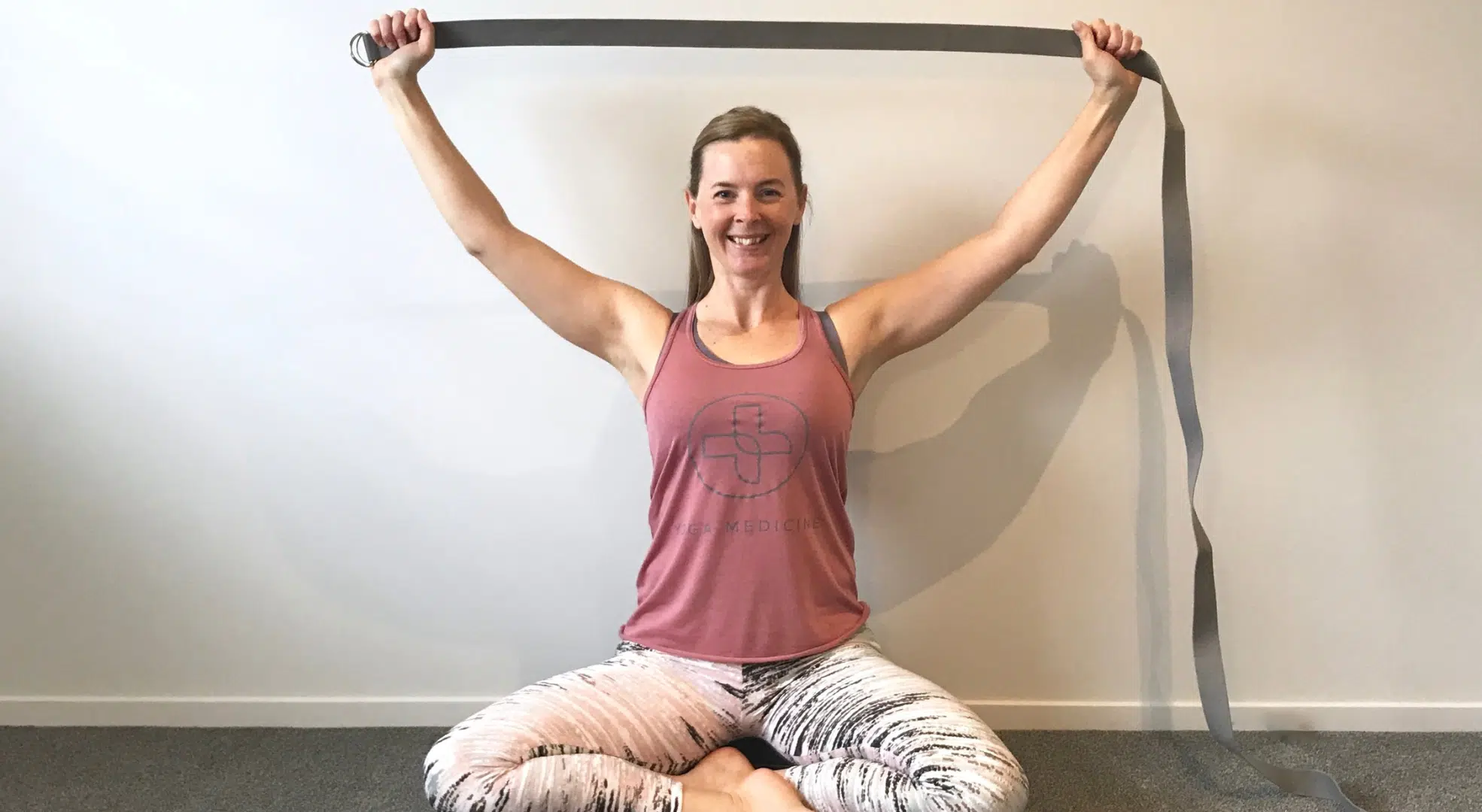

Target: Shoulders, chest
Stand or sit tall and hold the strap with both hands overhead. Slowly widen your grip and lower the strap behind your head as far as feels comfortable.
Keep your arms straight but relaxed, and avoid arching your back. Move with control and keep tension in the strap to stretch your chest and shoulder muscles. This stretch helps open up the front of the body and improves posture.
4. Cow Face Arms (Gomukhasana Arms)
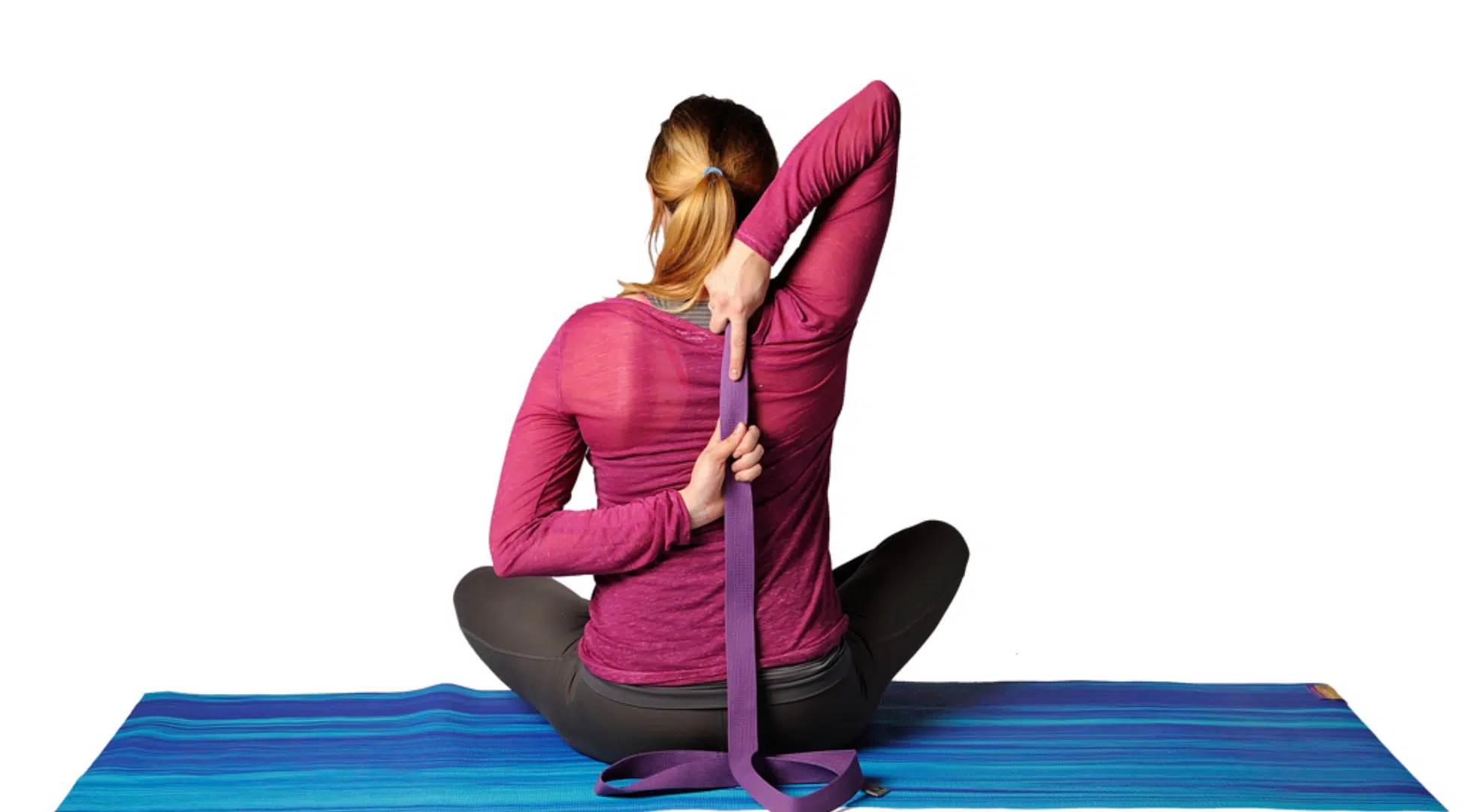

Target: Shoulders, triceps
Hold one end of the strap in one hand and bring that arm behind your head. Reach the other arm behind your back and grab the strap. Slowly “walk” your hands closer together using the strap as a guide.
Keep your spine tall and avoid leaning forward. This helps stretch your shoulders deeply and increases flexibility in the triceps and upper arms.
5. Bound Angle Pose (Baddha Konasana)
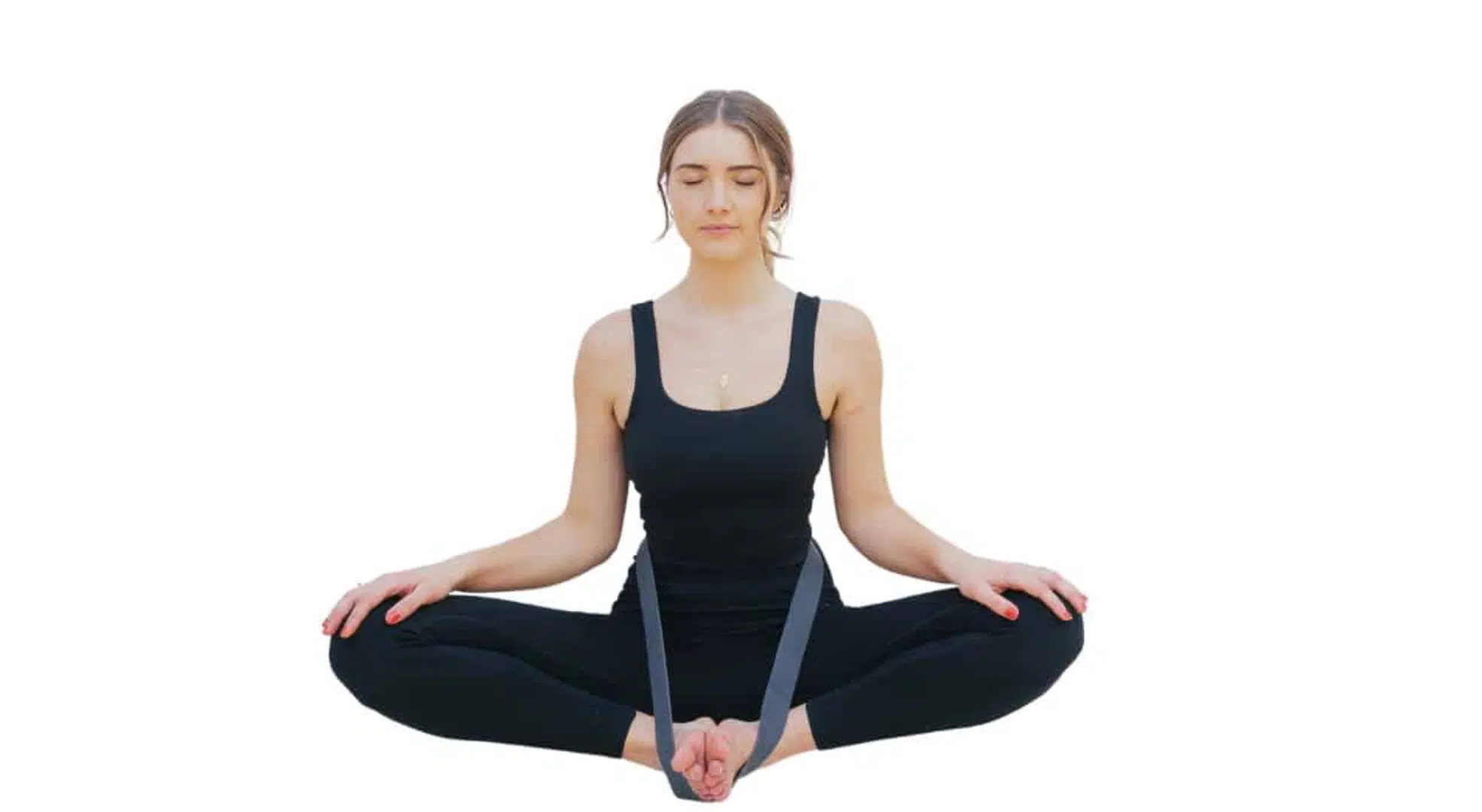

Target: Hips, inner thighs
Sit with your knees bent and the soles of your feet touching. Wrap the strap around your lower back and ankles to keep your feet close together. Let your knees drop out to the sides gently.
The strap offers support and helps prevent too much pressure on your knees. Keep your back straight and breathe as your hips slowly open. Don’t press the knees down; let gravity do the work.
6. Extended Leg Stretch (Supta Padangusthasana)
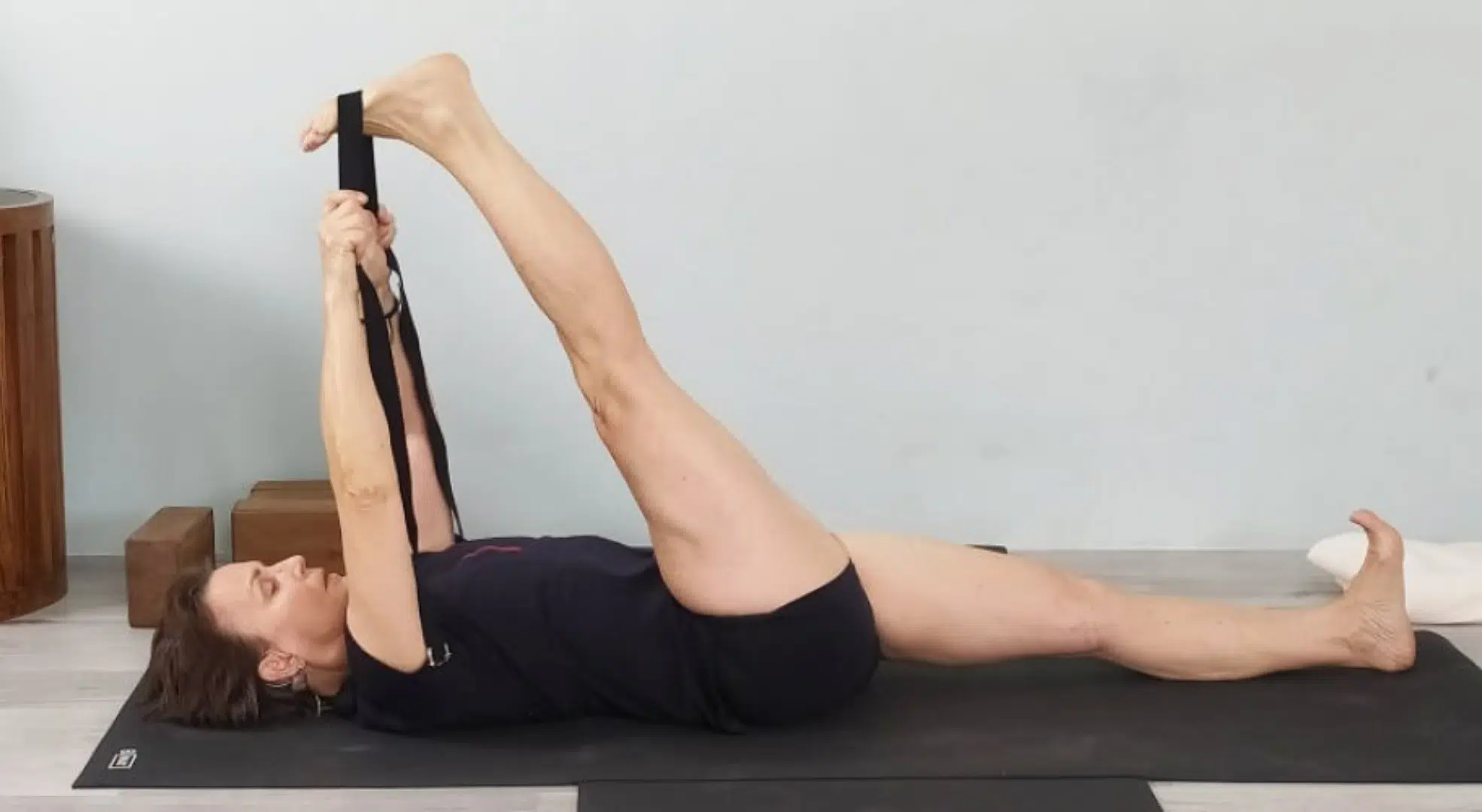

Target: Hamstrings, calves
Lie down on your back and raise one leg straight up. Loop the strap around the arch of your foot and hold both ends. Keep the other leg resting on the ground.
Use the strap to gently guide your raised leg toward you. Keep both legs active and avoid locking the knees. This stretch is great for tight hamstrings and improves flexibility in the back of your legs.
7. Dancer’s Pose (Natarajasana)
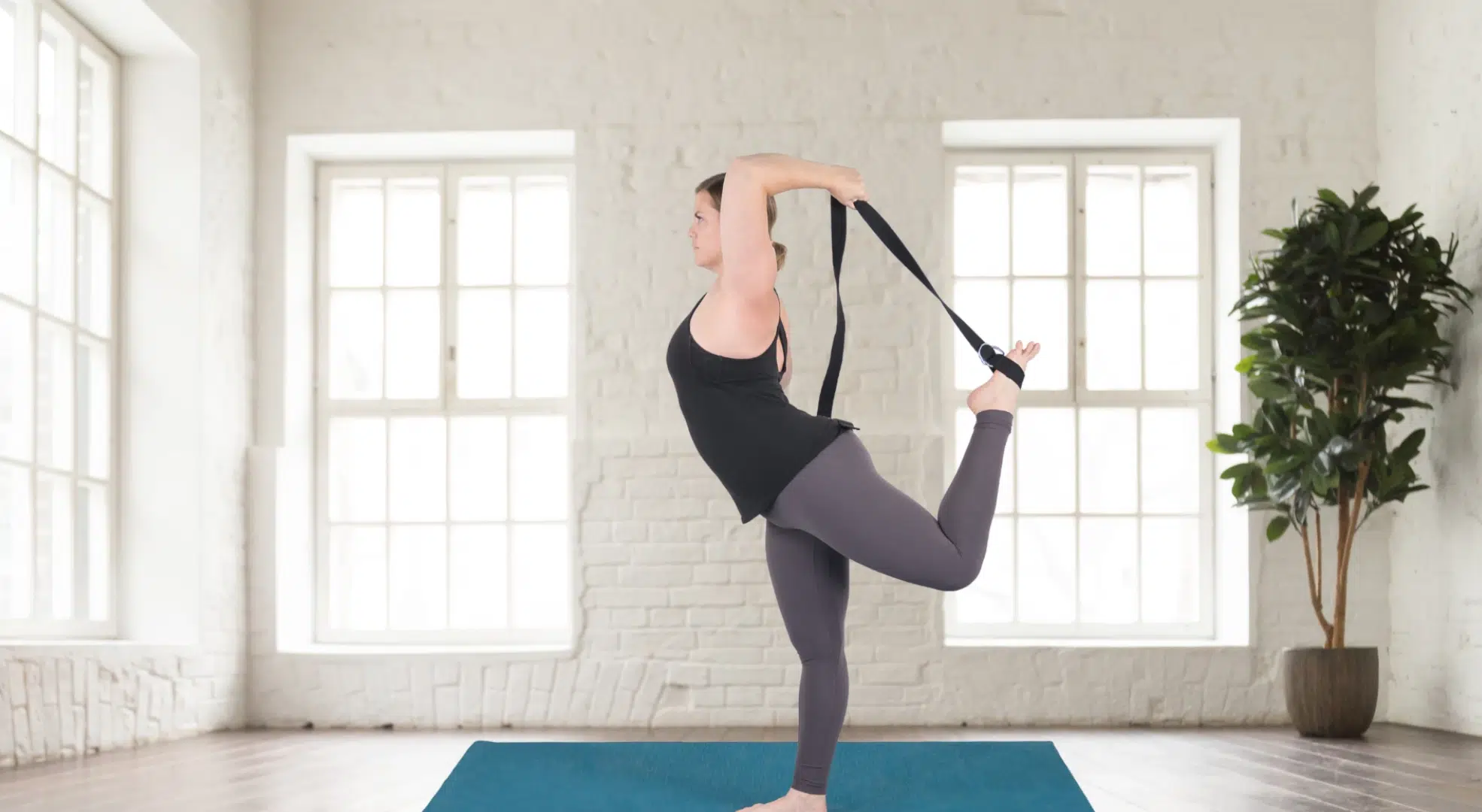

Target: Quads, shoulders, balance
Stand on one leg and loop the strap around the top of your other foot. Hold both ends of the strap with the same-side hand. Slowly lift your foot behind you and reach overhead with your other hand to hold the strap if needed.
Keep your chest lifted and use the strap to support balance. This stretch opens the chest and shoulders while working your balance and stretching the front of your thigh.
8. Side Body Stretch
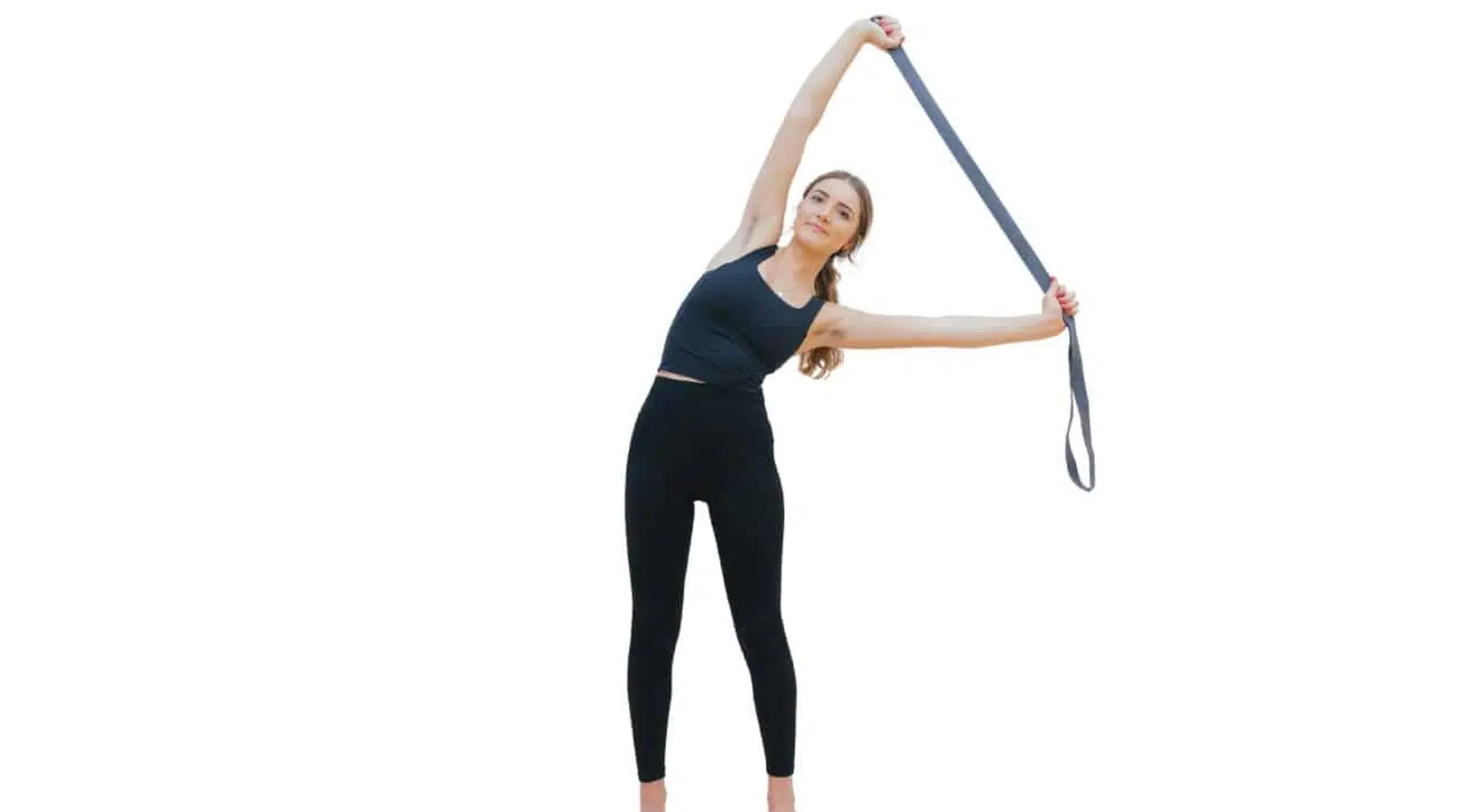

Target: Obliques, lats
Stand tall and hold the strap overhead with both hands slightly wider than shoulder-width. Keep your arms straight and slowly bend to one side, keeping the strap taut.
Feel the stretch along the side of your body without leaning forward or back. Hold for a few breaths, then switch sides. This stretch helps loosen up your waist, rib area, and upper back muscles.
9. Boat Pose Assist (Navasana)
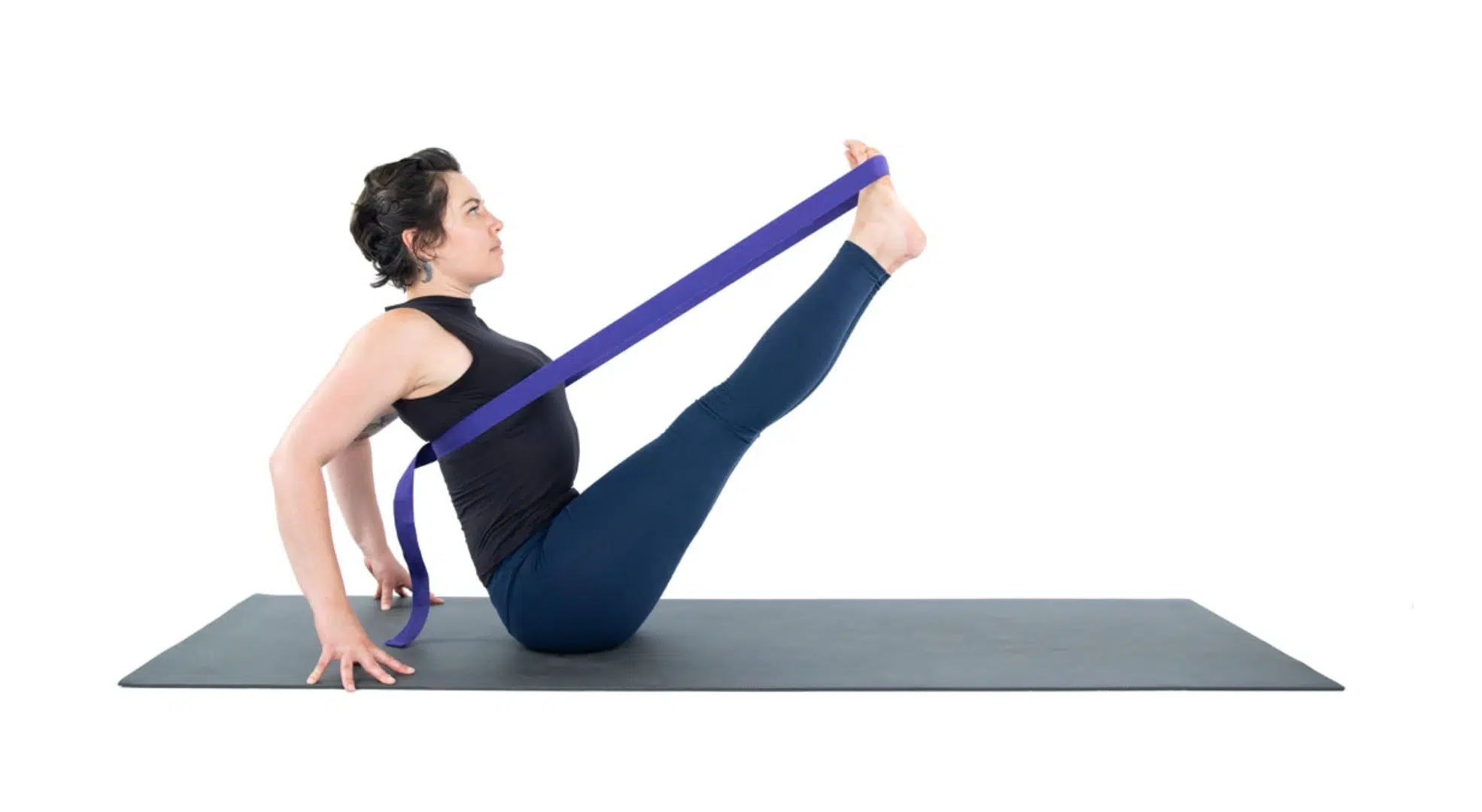

Target: Core, hip flexors
Sit with your knees bent and loop the strap under the soles of your feet. Hold the ends of the strap and lean back slightly, lifting your feet off the ground.
Use the strap to support your posture while straightening your legs. Keep your chest lifted and core engaged. The strap helps you balance and hold the pose longer without collapsing your back or straining the hips.
10. Hero Pose Quad Stretch (Virasana)
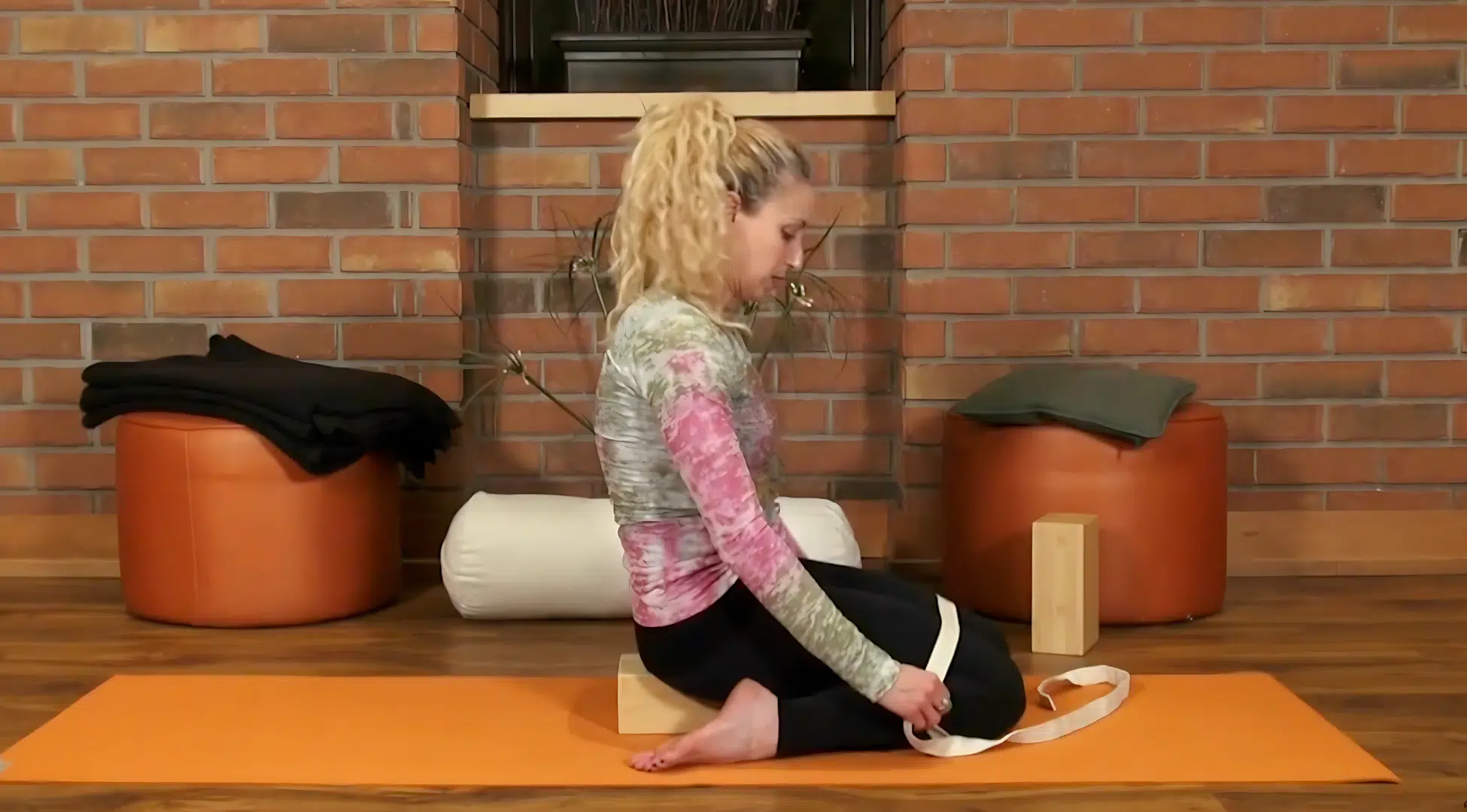

Target: Quads, knees
Sit on your shins with your knees together and feet slightly apart. If it’s hard to sit all the way down, loop the strap around your ankles and gently pull forward to create space and support.
This helps keep pressure off your knees while stretching the front of your thighs. Keep your spine straight and shoulders relaxed. Don’t force the stretch—use the strap to help ease into it safely.
11. Lying Spinal Twist with Strap
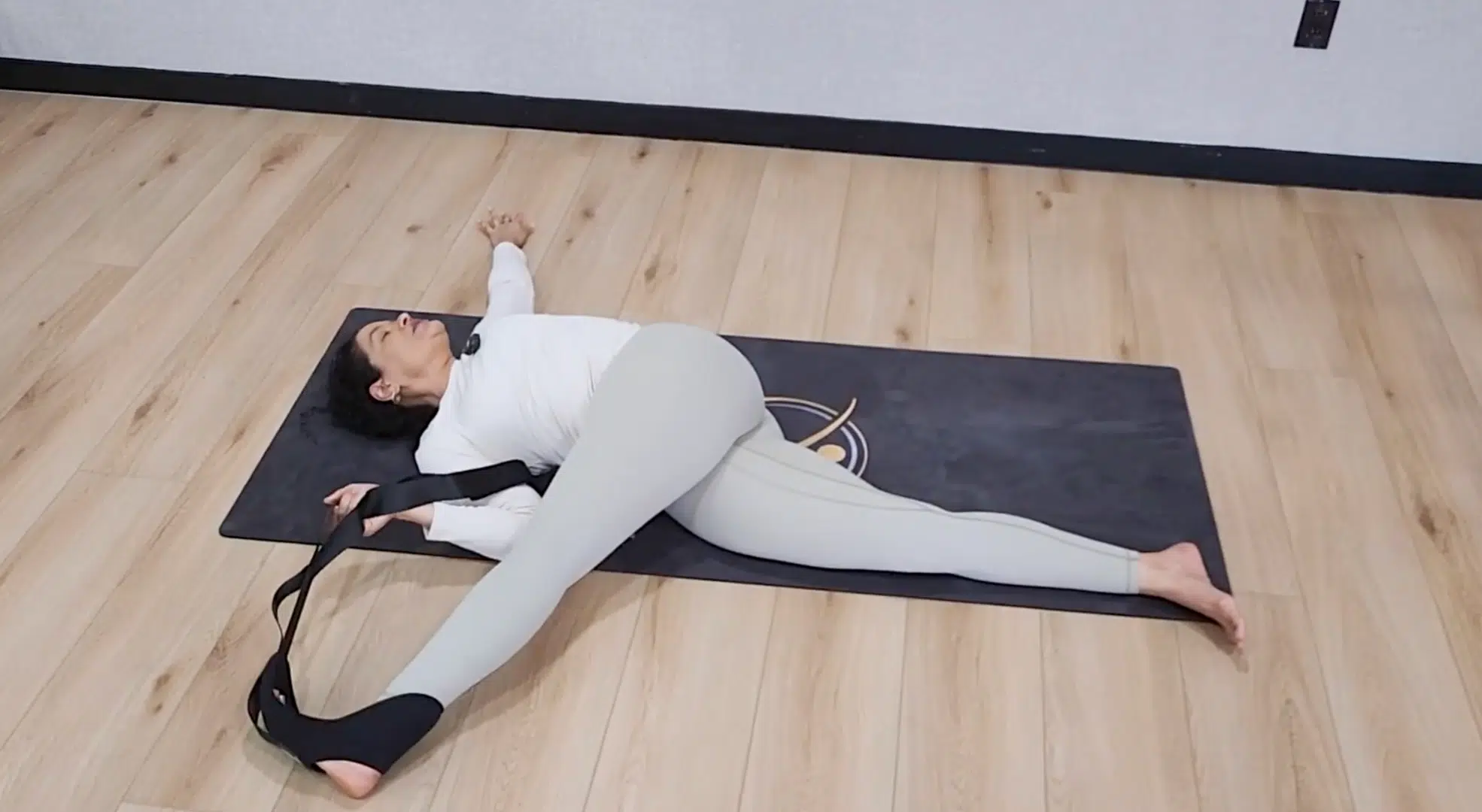

Target: Spine, outer hip
Lie on your back and loop the strap around the arch of one foot. Raise that leg and gently bring it across your body, keeping your shoulders flat on the floor.
Use the strap to guide your leg into a twist without forcing it. Keep the extended leg active and breathe deeply. This move helps stretch the lower back and outer hip while gently twisting the spine for a calming release.
12. Strap-Assisted Downward Dog
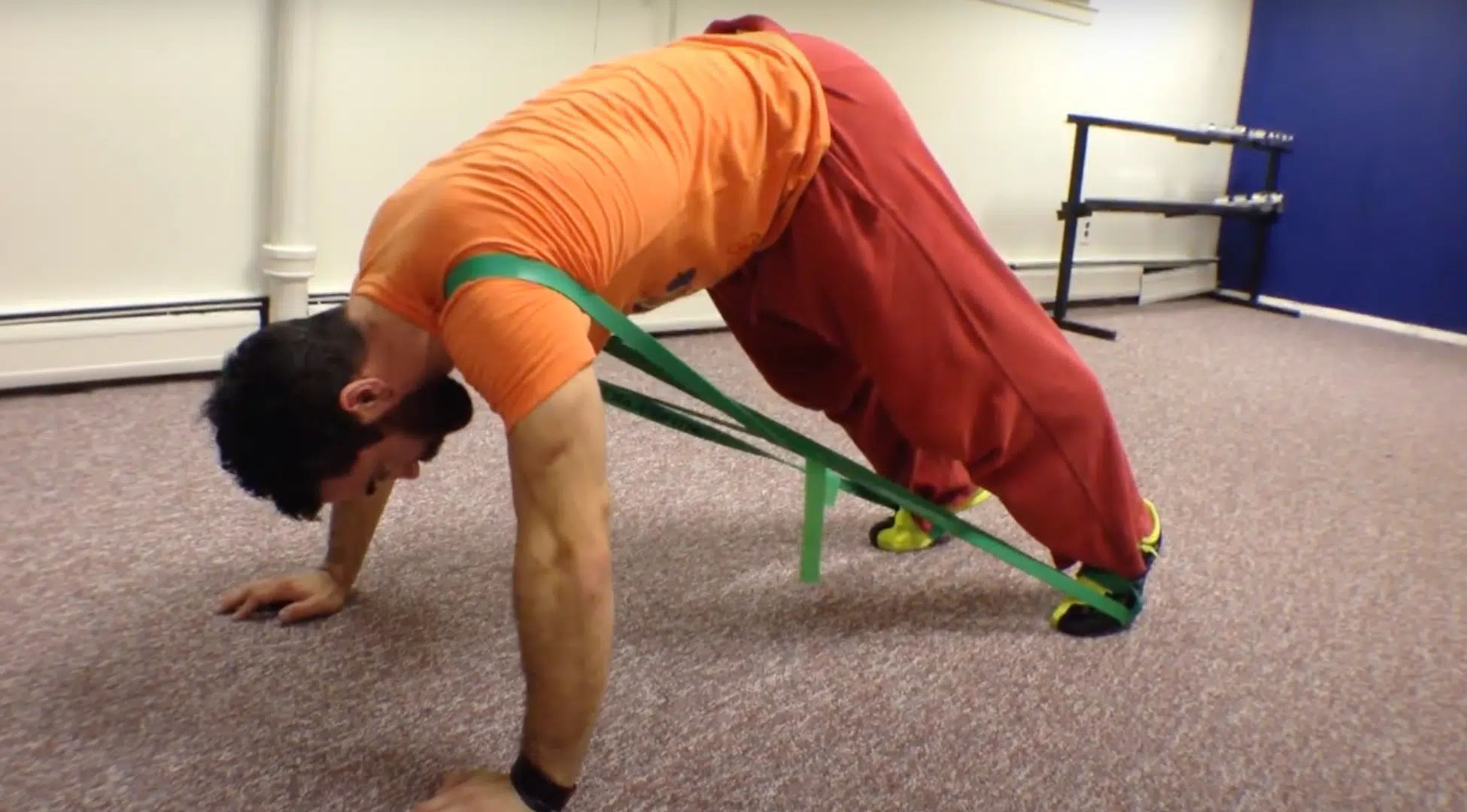

Target: Shoulders, hamstrings
Get into a Downward Dog position and loop the strap around your shoulders down to your feet. This keeps your arms shoulder-width apart and helps you maintain proper alignment.
Press your hips up and back, keeping a slight bend in the knees if needed. The strap helps relieve pressure in the shoulders and keeps them stable, while also deepening the stretch in your hamstrings and calves without overreaching.
13. Calf Stretch
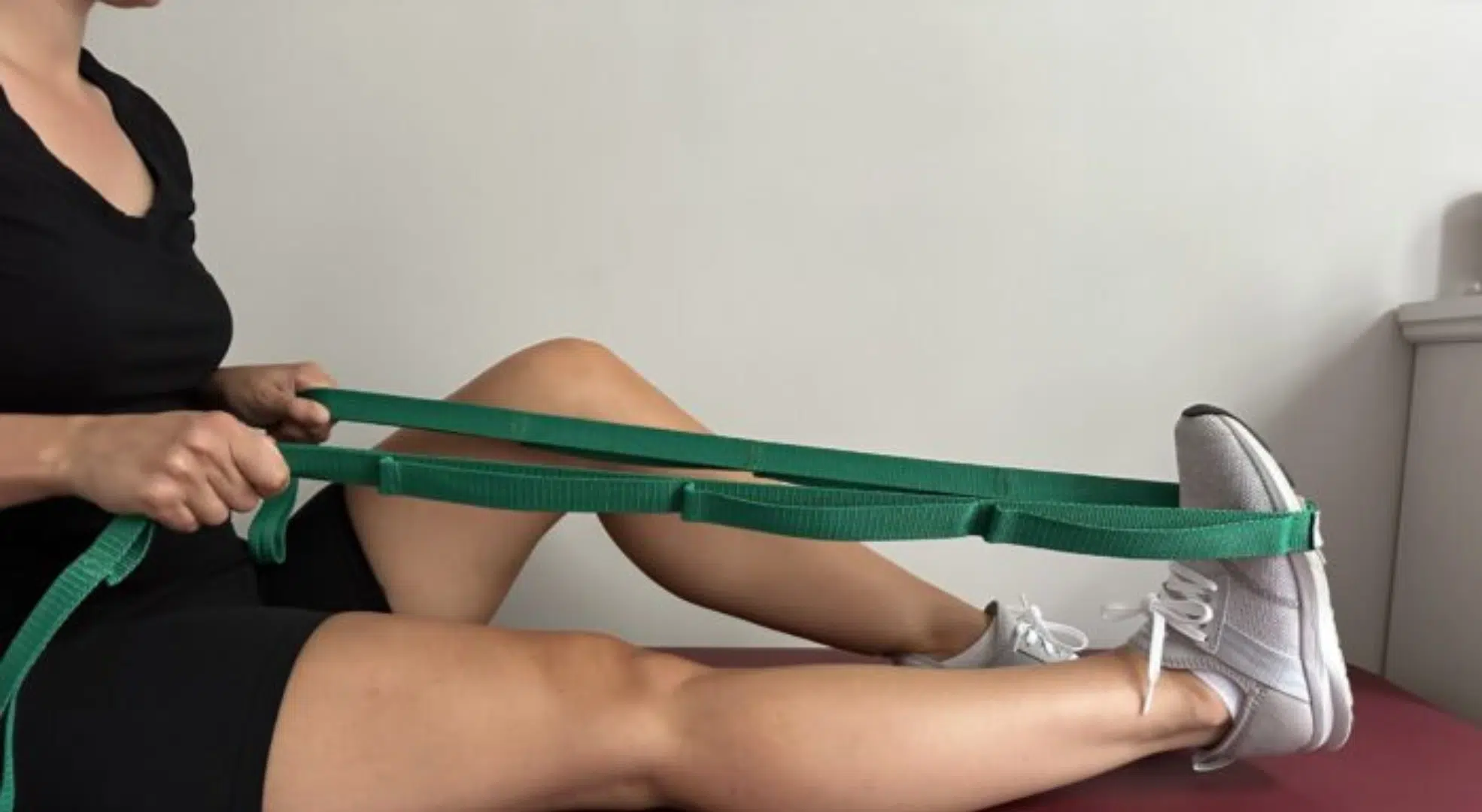

Target: Calves, ankles
Sit down comfortably on the ground with your legs straight in front of you. Wrap the strap around the toes of your foot and gently pull the ends toward you. Keep your back straight and leg extended.
This helps stretch the calf muscle and the Achilles tendon without needing to lean forward too much. It’s a gentle way to ease tightness in the lower legs and improve ankle movement.
14. Legs Up the Wall with Strap
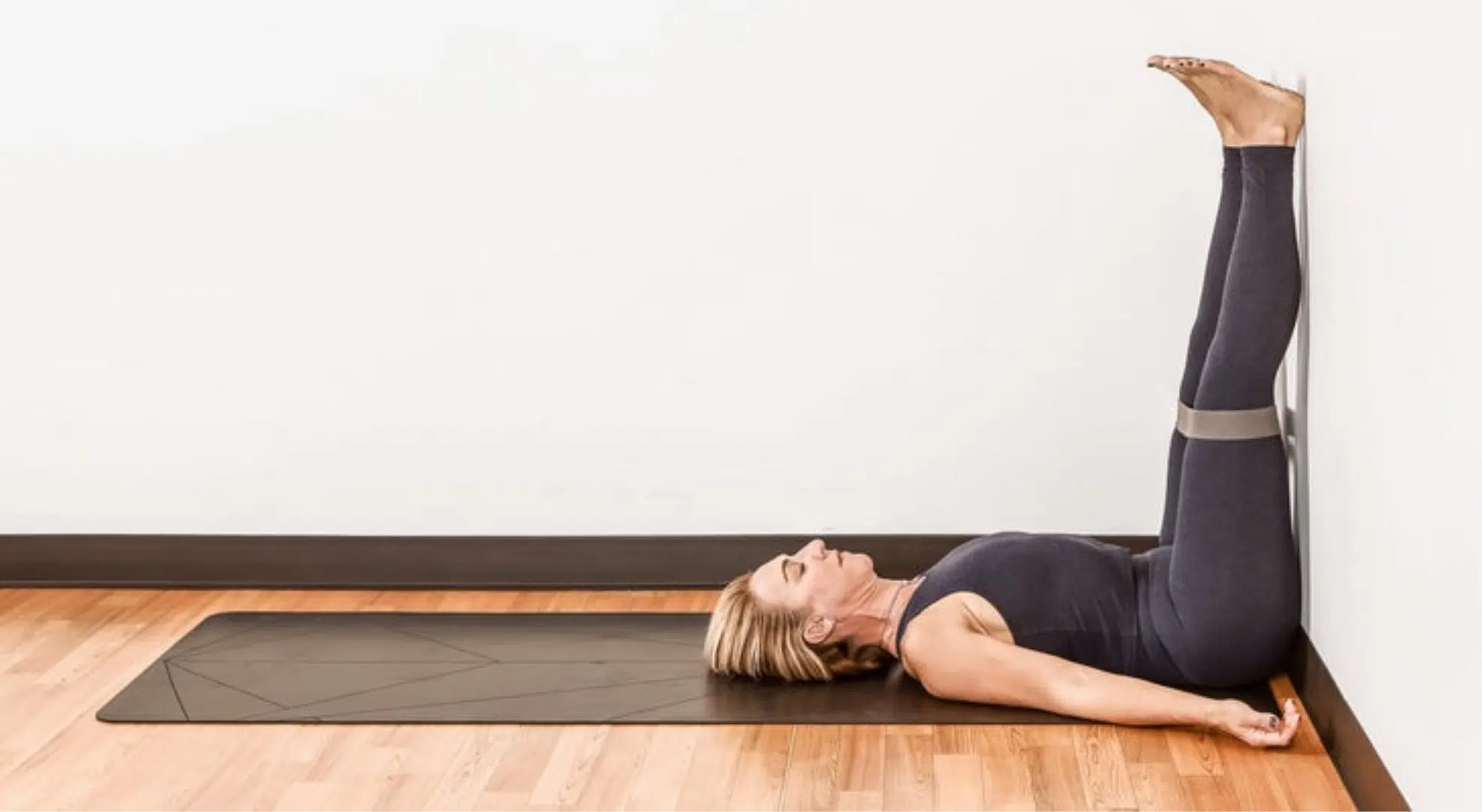

Target: Lower back, hamstrings
Lie down with your legs up against the wall and wrap the strap around both thighs, just above the knees. Tighten the strap enough to hold your legs gently together without squeezing.
Let your arms rest at your sides and breathe deeply.
The strap keeps your legs from falling apart and helps your body fully relax. This pose is great for reducing swelling and releasing tension in the back and legs.
15. Bridge Pose Support
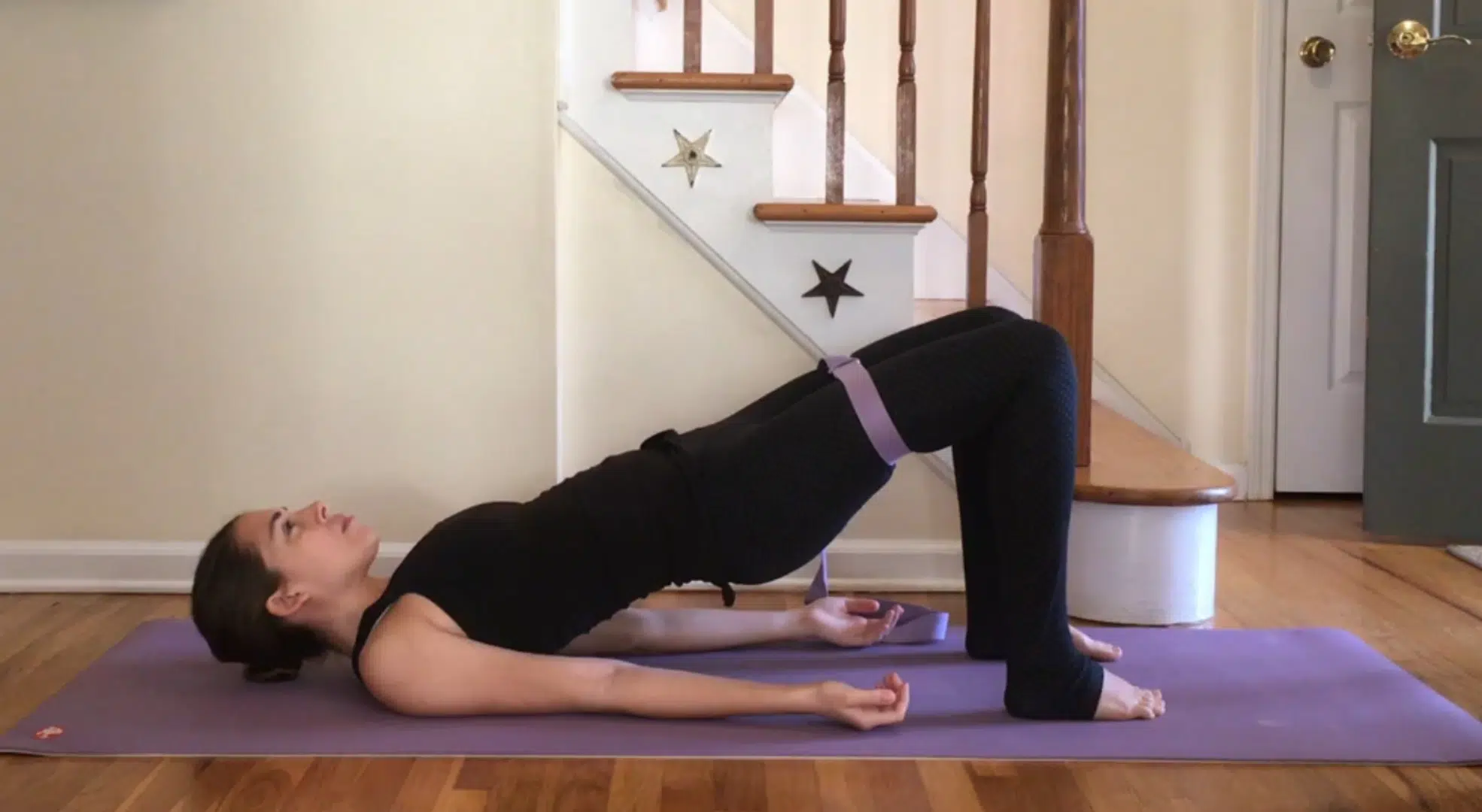

Target: Hips, lower back
Lie on your back with knees bent and feet flat on the floor. Wrap the strap around your thighs to keep them hip-width apart. As you lift your hips into bridge pose, the strap helps keep your legs from splaying outward.
This makes the pose more stable and protects your lower back. Keep pressing through your feet and squeezing your glutes while breathing steadily.
16. Standing Forward Fold with Strap
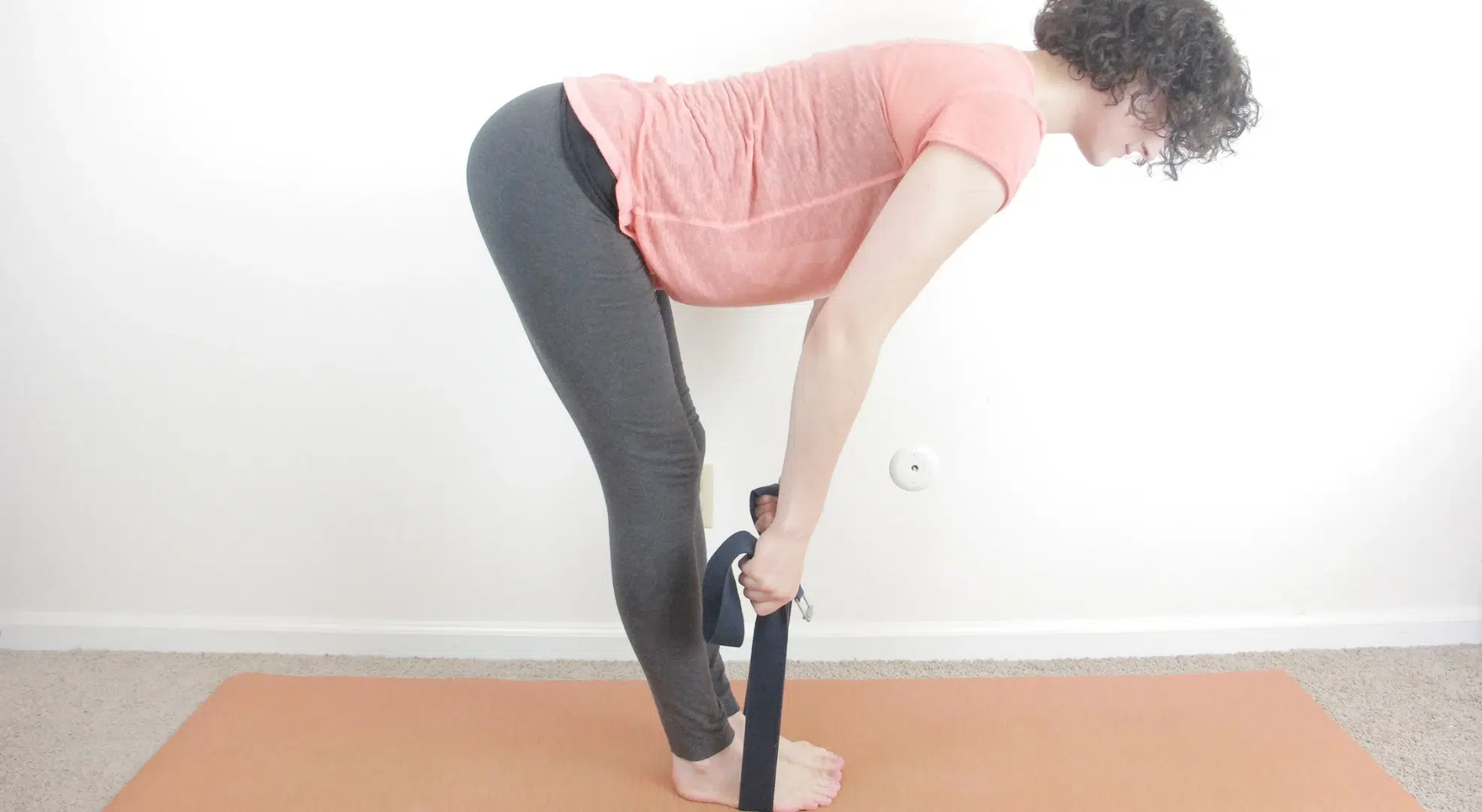

Target: Hamstrings, lower back
Stand with your feet hip-width apart and place the strap under the balls of your feet. Hold the ends in each hand and gently pull as you fold forward from your hips.
Keep a soft bend in the knees if needed and let your head hang heavy. The strap gives you more control and support, helping you deepen the stretch safely without rounding your back.
17. Camel Pose Shoulder Opener


Target: Shoulders, chest, back
Kneel with your knees hip-width apart. Loop the strap around both ankles if your hands can’t reach them directly. Reach back and grab the strap ends, then lift your chest and press your hips forward into camel pose.
The strap helps you get the chest-opening benefits even if your flexibility is limited. Keep your head neutral and avoid dropping it too far back to protect your neck.
18. Supported Tree Pose


Target: Balance, hips
Stand tall and bend one knee to bring your foot toward your inner thigh. Use the strap under your bent foot to help lift and guide it into place if your hands can’t reach.
Hold the ends of the strap with your hand or hands to support the pose. This helps you stay steady and get into tree pose with better form. Focus on your balance and press your standing foot into the ground.
19. Neck and Upper Back Traction Stretch
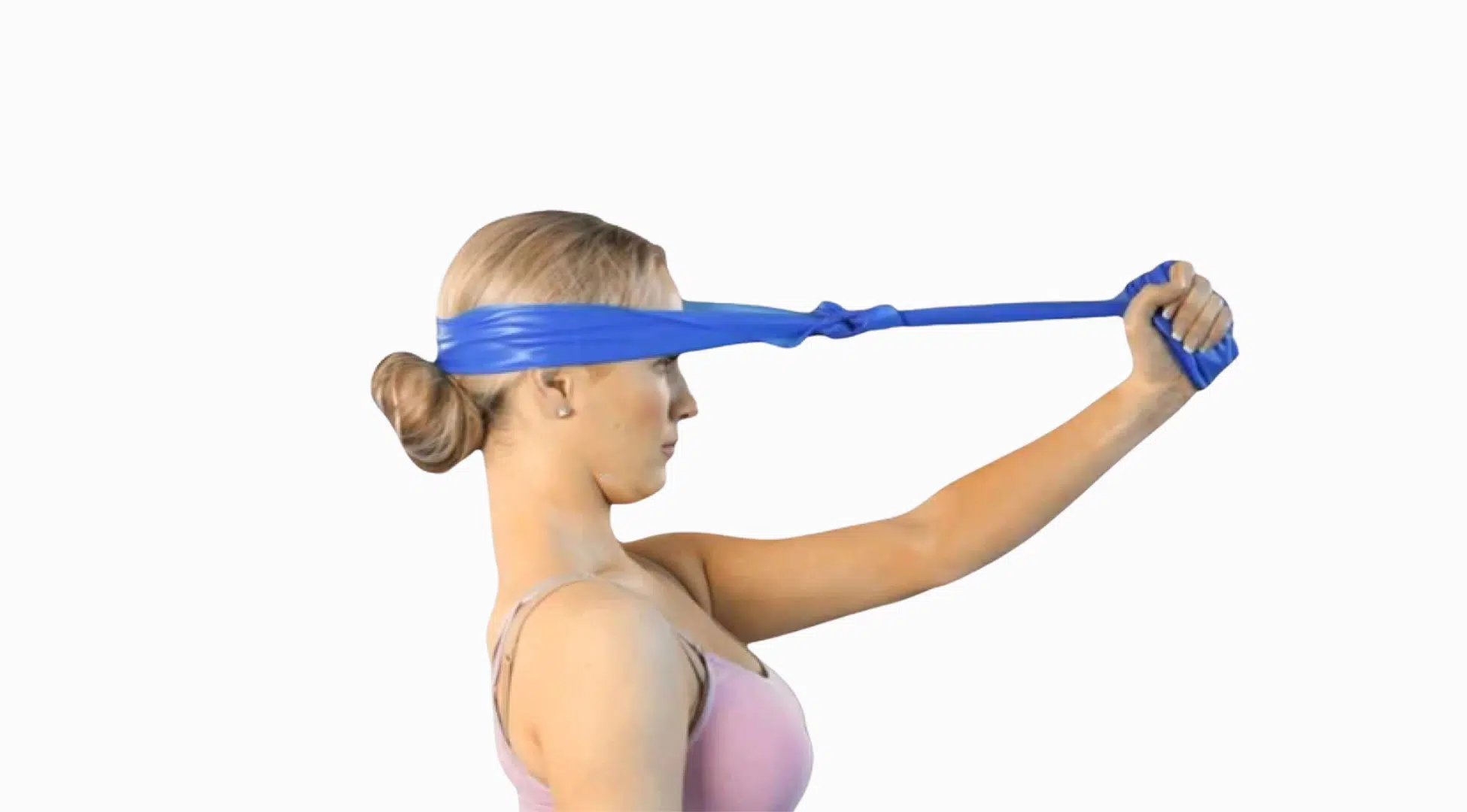

Target: Neck, traps
Sit or stand and wrap the strap around the back of your head just above the neck. Hold both ends of the strap with your hands in front of you.
Gently pull forward and slightly upward to create a light stretch in the neck and upper back. Keep the pull soft just enough to feel a gentle release. This move can help relieve tension from staring at screens or sitting too long.
Yoga Band Stretches (Resistance Band Adaptations)
A yoga band (or resistance band) is stretchy, unlike a yoga strap, which doesn’t stretch. Bands are better when you want more resistance and strength-building, while straps are best for support and alignment.
If you’re looking to add light strength work or improve control during stretches, a yoga band can help. It’s especially useful in active poses or when you want some bounce and give during movement.
Here are a few simple and effective yoga band stretches you can try:
20. Lying Leg Raise
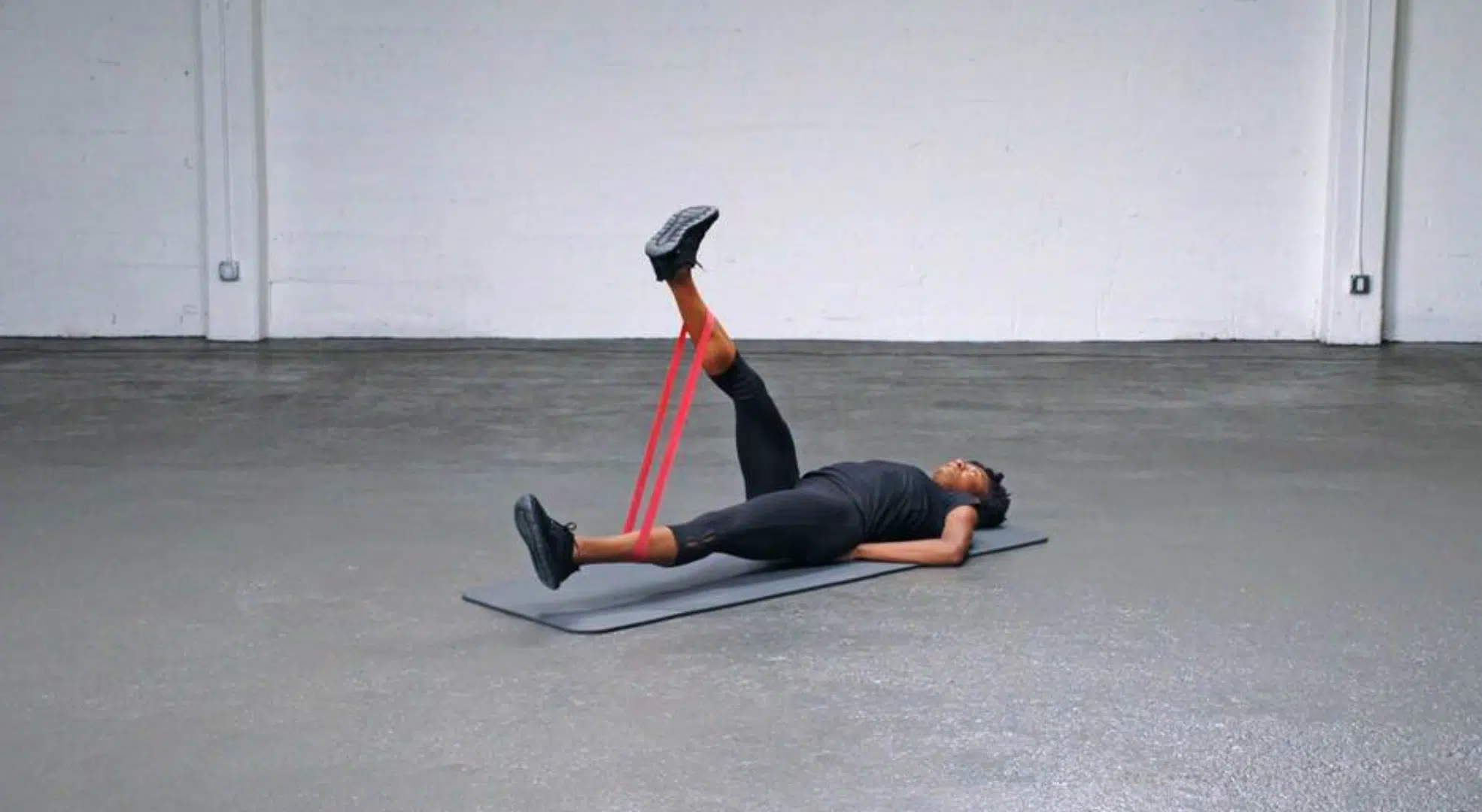

Helps with: Hamstrings and hip control
Lie on your back and loop the band around one foot. Keep your other leg flat on the floor. Use the resistance from the band to guide your leg up and press gently against it for control.
Don’t yank; use steady pressure. This stretch builds control while loosening tight legs.
21. Kneeling Quad Stretch
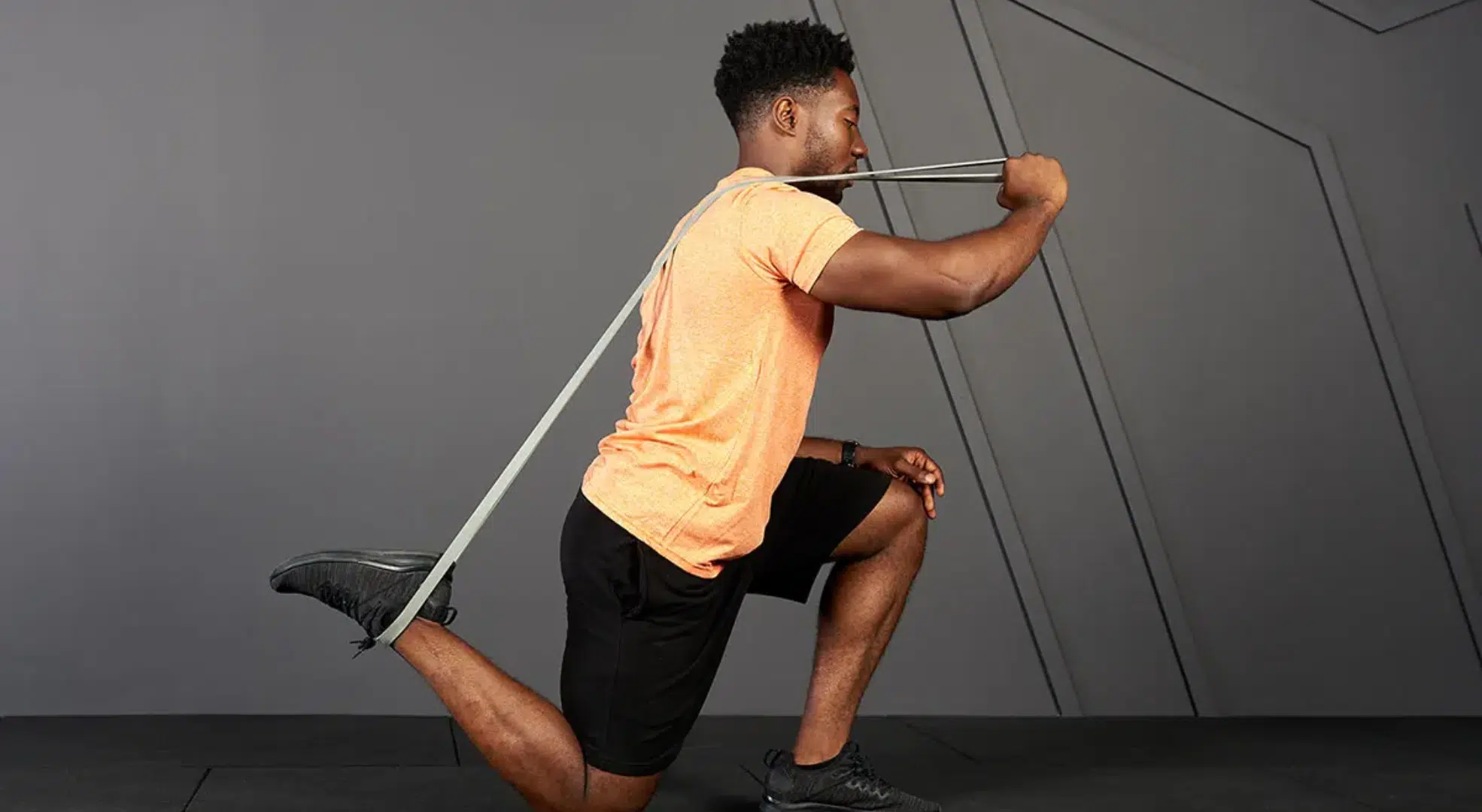

Helps with: Quads and hip flexors
Kneel on one leg with the other foot behind you. Wrap the band around your back foot and hold the ends in your hand. Gently pull to stretch the front of your thigh.
Keep your chest lifted and avoid leaning forward. The stretch should feel firm but not painful.
22. Banded Glute Bridge
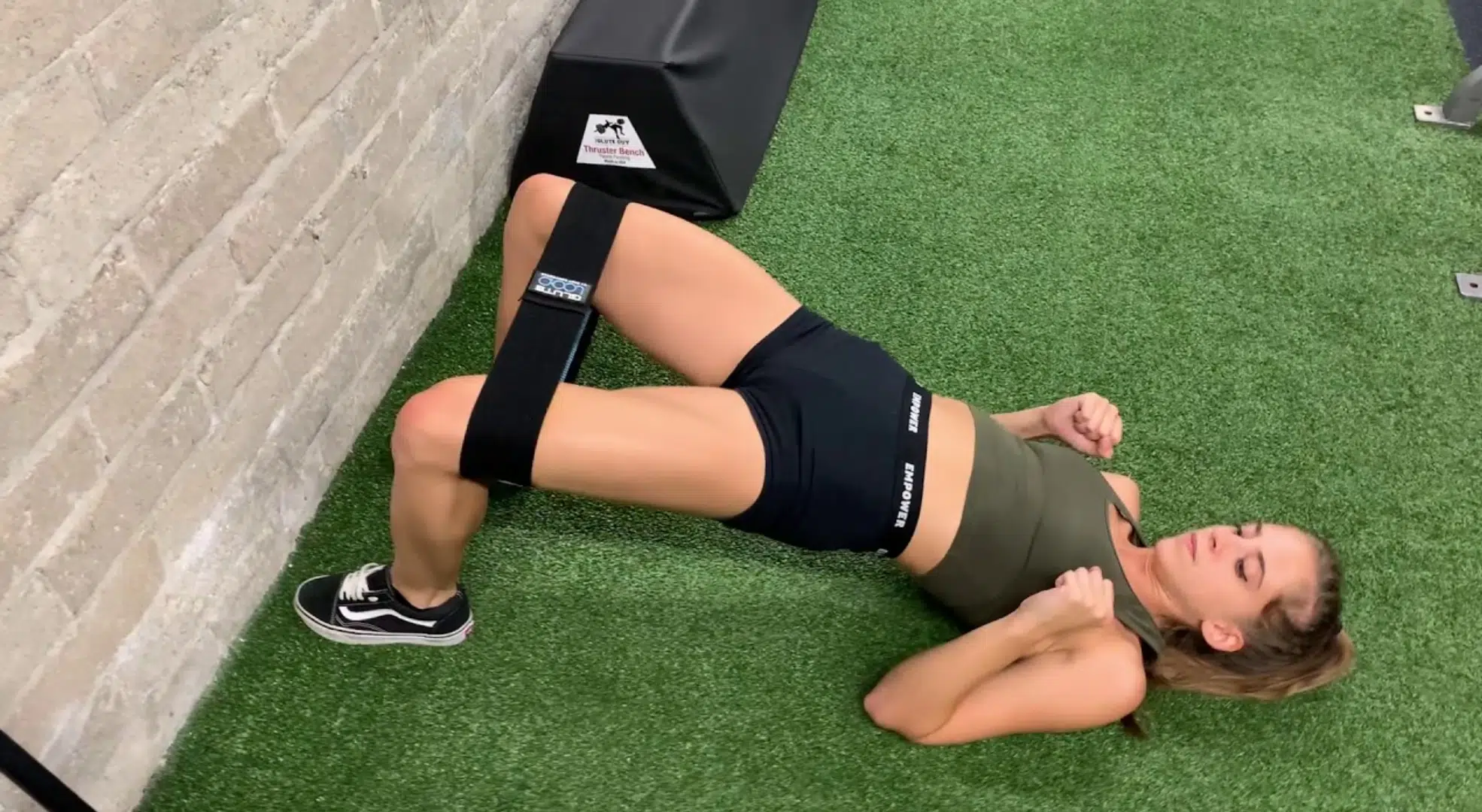

Helps with: Glutes, hips, and thighs
Lie on your back with knees bent and a band around your thighs, just above your knees. Keep your feet flat and push your hips up into a bridge.
The band gives you extra resistance and helps you keep your knees from falling outward. This strengthens the glutes and hips.
23. Shoulder Flexion Pull
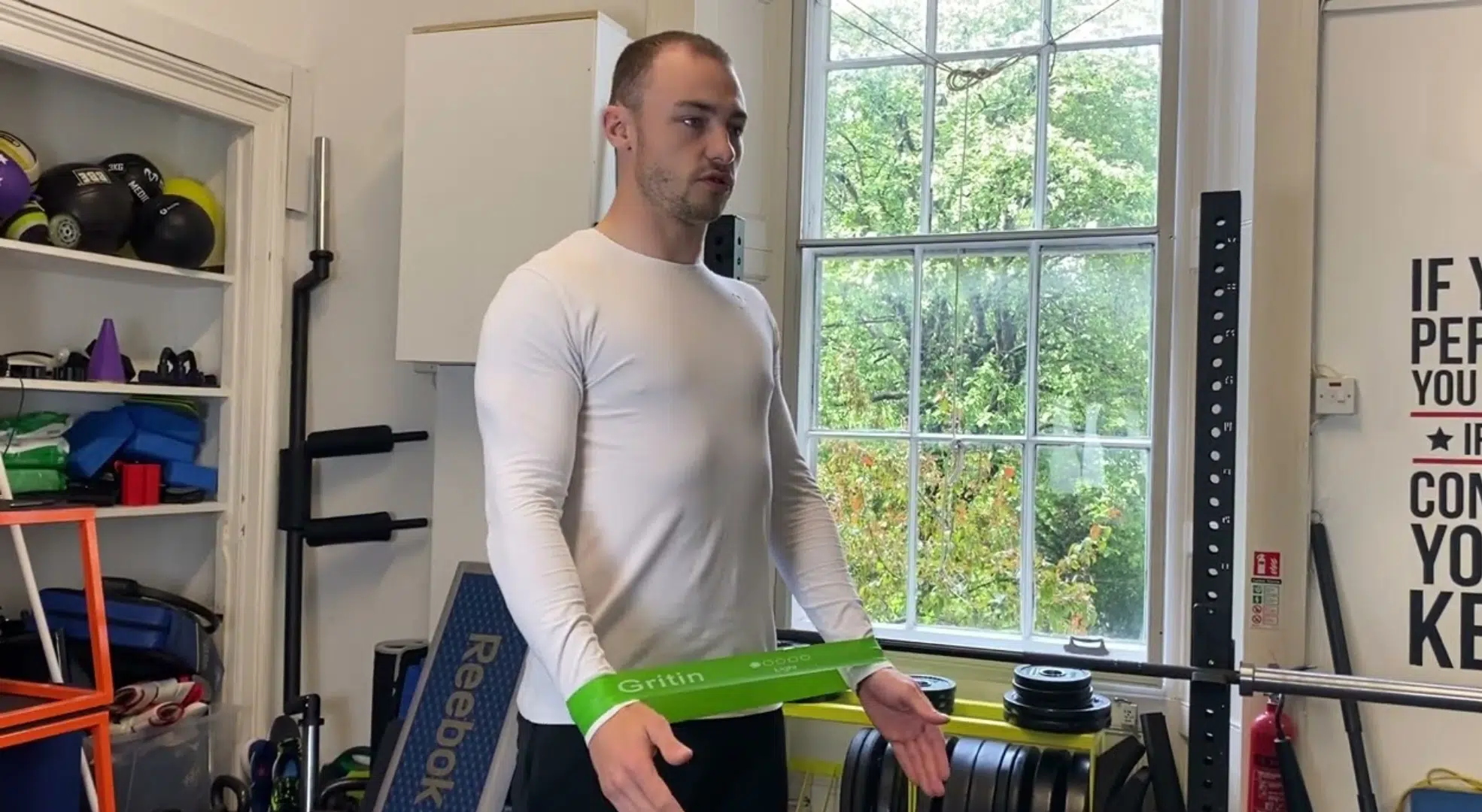

Helps with: Shoulders and upper back
Hold the band in front of you with both hands and arms straight. Raise your arms overhead and gently pull the band apart to stretch your shoulders. Move slowly and with control.
This is great for people with stiff shoulders or upper back tightness.
24. Banded Hip Opener
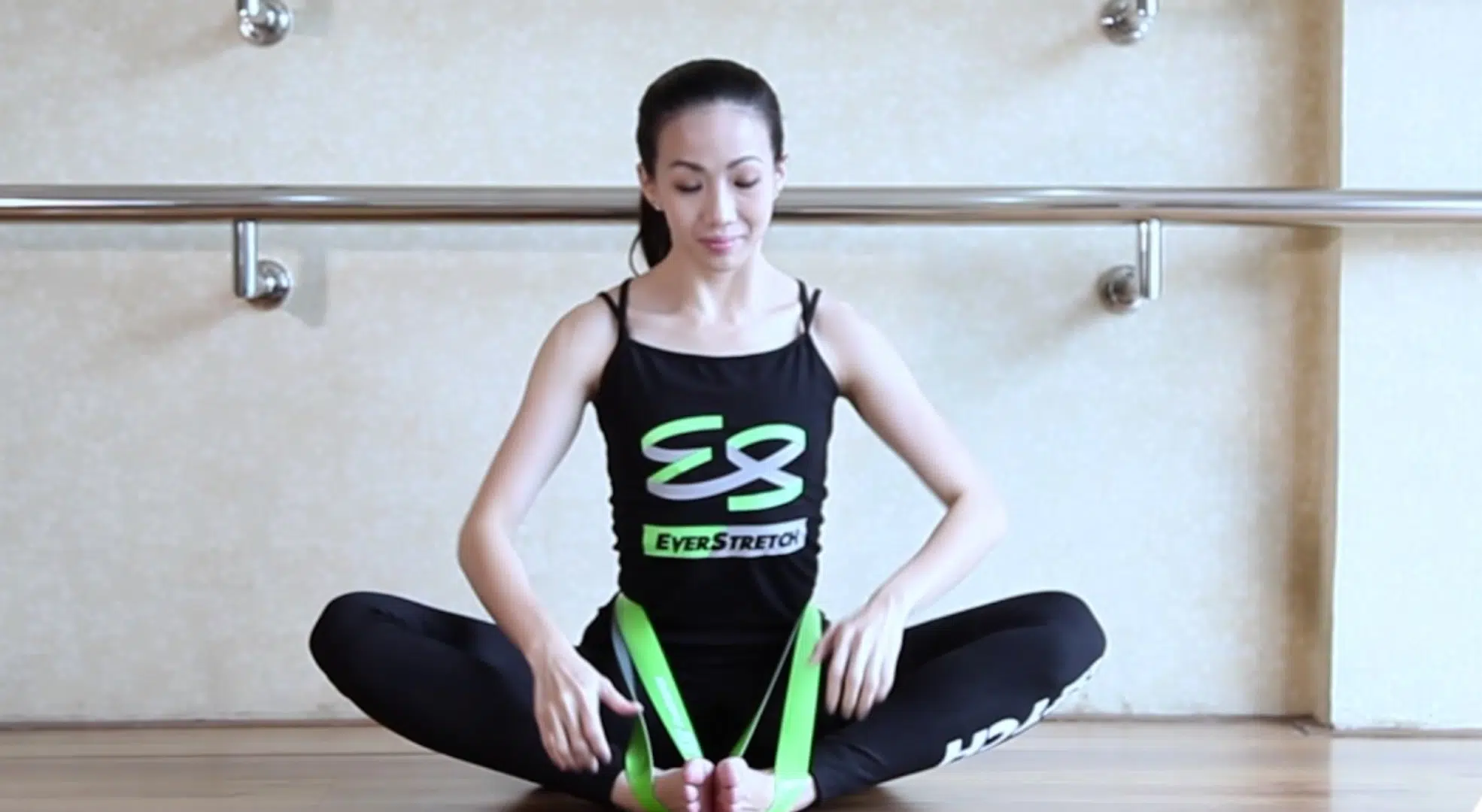

Helps with: Hips and groin area
Sit with your feet together and knees bent out to the sides (like butterfly pose). Wrap the band around your thighs and gently press your knees outward against the resistance.
The band adds strength work while also helping stretch the inner thighs and hips. Go slow and breathe as you hold.
How to Choose Between a Yoga Strap and a Resistance Band
If you’re trying to decide between a yoga strap and a resistance band, it helps to understand what each one is designed for. While they may look similar, they serve very different purposes.
One supports stretching and mobility, and the other adds challenge to your workouts. Here’s a simple comparison to help you choose:
| Feature | Yoga Strap | Resistance Band |
|---|---|---|
| Main Use | Stretching and flexibility | Strength training and rehab |
| Material | Non-stretch cotton or nylon | Stretchy rubber or latex |
| Resistance | No stretch or resistance | Offers varying levels of resistance |
| Best For | Yoga poses, deep stretches | Muscle building, physical therapy |
| Control Level | High control and stability | Varies with stretch and tension |
| Common Length | 6 to 8 feet | Comes in loops or long strips |
In short, if you want help reaching and holding stretches, a yoga strap is your best choice.
But if you’re looking to build strength, recover from injury, or add resistance to your workouts, a resistance band is the better tool. You can also use both if you want to support both flexibility and strength.
Tips to Stay Safe While Using Straps and Bands
Using yoga straps or resistance bands can really help with stretching and strength, but only if you use them the right way. To keep your body safe and avoid injury, follow these simple tips:
- Check for Damage: Before you use a band or strap, look for tears, frays, or weak spots. A damaged gear can snap and cause injury.
- Use Proper Form: Keep your posture strong and joints in line. Don’t force movements; use slow, steady motions.
- Start Light: If you’re using resistance bands, begin with low resistance and work your way up. Going too hard too fast, can lead to strain.
- Avoid Wrapping Around Joints: Don’t place bands or straps directly on knees, elbows, or wrists. It puts too much pressure on these areas.
- Keep a Good Grip: Hold straps or bands firmly but gently. Slipping can cause sudden jerks that may hurt muscles.
- Don’t Overstretch: Stretch only until you feel gentle tension. Sharp pain or pulling too far can cause injury.
- Stay Focused: Don’t multitask while using bands or straps. Stay aware of your movement to prevent sudden slips or strain.
Staying mindful, using good gear, and taking your time can make a big difference. With a little care, you can stretch or train safely and feel better after every session.
Conclusion
Yoga strap stretches have really helped me feel less stiff and more relaxed, and I hope they can do the same for you. They’re easy to do, even if you’re not super flexible.
Now that you’ve seen how simple they are, try using a strap during your own quiet time—maybe after sitting too long or before bed. It only takes a few minutes, and your body will thank you.
Just remember to go easy. Listen to how your body feels and don’t push too hard. These stretches are here to help you feel better, not worn out.
If these made a difference for you, there’s more waiting for you. Check out the other blogs for more easy, down-to-earth tips to keep your body feeling good every day!


